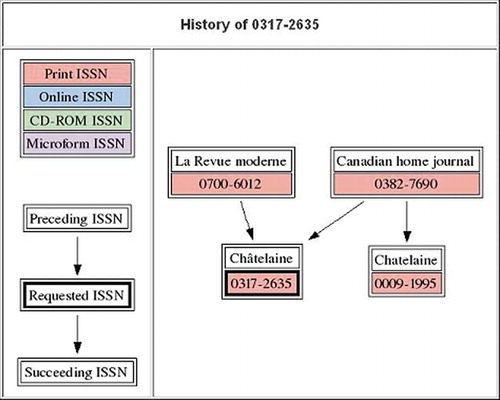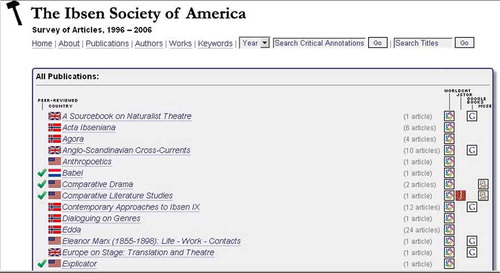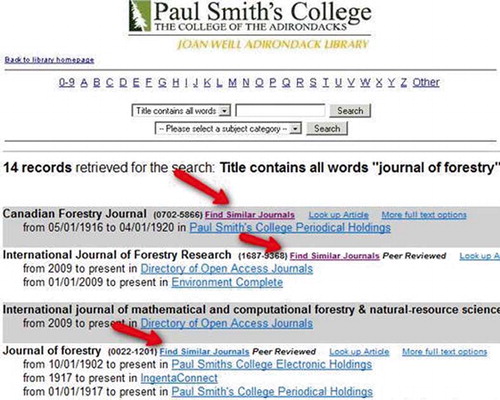Abstract
The Online Computer Library Center's xISSN Web service is an application program interface (API) that enables libraries to retrieve serials metadata from WorldCat in a parsable form. The service allows libraries to use a script language to “mash” or combine the metadata with local serials holdings information, thereby enhancing their Web-based catalogs, databases, or A–Z lists. This tactics session provided an overview of the xISSN Web service, and provided two examples of how xISSN metadata has been used with scripts to improve the functionality of academic library A–Z lists.
The xISSN Web service offered by the Online Computer Library Center (OCLC) provides libraries with the opportunity to enhance the serials data found in their online catalogs, databases, or A–Z lists. In this session, Roy Tennant described the xISSN Web service, and two librarians, Adam Traub and Mike Beccaria, discussed how their libraries have implemented the service in order to flag peer-reviewed journals in an A–Z list and to improve the browsability of electronic resources in an A–Z list, respectively.
Tennant, a Senior Program Officer at OCLC, began the session by giving an overview of OCLC's Web services, a growing suite of application program interfaces (APIs) that enables libraries to use OCLC WorldCat data in a structured form. One offering in this suite, xID, allows grouping of alternate identifiers, such as those for print, electronic, and microform, of the same work; facilitates mapping between different identifiers (e.g., International Standard Book Numbers [ISBNs] and Library of Congress Control Numbers [LCCNs]) of the same edition; and enables retrieval of basic metadata, such as title and author, about a work. Of relevance to this presentation was the xISSN Web service, which relates different editions of the same serial (for example, print and electronic) and historical relationships, such as International Standard Serial Number (ISSN) changes that result from title changes, mergers, or splits. The xISSN Web service allows users to harvest serials metadata in multiple parsable formats, including Extensible Markup Language (XML) and Extensible Hypertext Markup Language (XHTML).
The Title History Tool on the OCLC WorldCat website is just one example of how the xISSN Web service can be used. Here, the metadata in an XML format has been exposed to software to dynamically and graphically depict the life of a serial (). Similarly, the service may be used to indicate which journals in an A–Z list are peer-reviewed (). The xISSN Web service has a demonstration page, as well as a link to API documentation, where programmers can determine what they will need to retrieve a list of ISSNs.Footnote 1 The xISSN database currently holds approximately 740,000 ISSNs.
Adam Traub, a librarian at St. John Fisher College, discussed how he had adapted a script that uses the xISSN Web service to tag peer-reviewed journals in a library's journal A–Z list (). Traub explained that as part of the first-year instruction program, he and other librarians at St. John Fisher College teach freshmen how to distinguish between popular, trade, and scholarly journals. It is usually difficult to explain to students why after searching one database to find articles on a topic, they must search a second database (such as Ulrichsweb) to confirm that the journal the articles appeared in is peer-reviewed. In order to simplify bibliographic instruction and make it easier for students to get the articles they need, Traub decided to set up a script that would tag peer-reviewed journals in the library's A–Z list.
FIGURE 3 Using the xISSN Web service to tag peer-reviewed journals in the St. John Fisher College Library A–Z list.

Traub encouraged attendees to try the script, noting that a simple edit of three or four lines of the forty lines of code is all that is necessary to adapt the script to their own institution. He noted that those who are not techies should “be brave,” since modifying and setting up the script is really not that difficult. In the future, he would like the ability to choose locally which of the sixty-three sources the xISSN uses to flag peer-reviewed journals; at present, all sources must be used.Footnote 2 Traub's script is available at the Information Delivery Services (IDS) Project website.Footnote 3
Mike Beccaria then discussed how he had used the xISSN Web service to improve the browsability of electronic resources at Paul Smith's College Library (). While libraries have a lot of materials that students do not know about, libraries do not always make it easy for students to find those materials. Quoting Peter Morville, author of Ambient Findability, Beccaria noted that:
Findability Precedes Usability
In the Alphabet and on the Web
You Can't Use What You Can't FindFootnote 4
At Paul Smith's College, for example, the library's A–Z list allowed students to browse journals by broad subject (for instance, Arts, Architecture & Applied Arts) but made it difficult to find similar journals on a narrower topic, such as forestry. Beccaria demonstrated how he was able to overcome this problem quickly and easily using scripts and the xISSN Web service. A Python script gathers data, including title, ISSN, and subject headings from machine-readable cataloging (MARC) 650 fields from WorldCat and stores that information in a MySQL database; a Hypertext Preprocessor (PHP) script then displays the journals to the patron, with JavaScript adding links to the Serials Solutions A–Z list. The result is an A–Z list that provides students with a “Find Similar Journals” link, so that journals covering the same subject can be easily retrieved. A side benefit of the script was the ability to generate a report that ranked the most common subject headings in the library's collection of serial titles. For example, at Paul Smith's College Library, the most common value in subject heading fields (MARC 650 field, a subfield) was “Law.” In response to a question from the audience asking whether the script could be modified to grab class numbers rather than subject headings, Beccaria noted the script could be edited to retrieve any field in the MARC bibliographic record.
Beccaria plans to develop a better algorithm to return more accurate results, improve the visual appearance of the page, add tags to indicate that the journal is peer-reviewed, and explore whether the data could be used for collection assessment. His code is available on Google Code.Footnote 5
The presenters emphasized the ease with which these scripts and mash-ups can be created or modified; the scripts described in the presentation were all set up in about a day or less. With the OCLC xISSN Web service, all that is needed to add value to a library's A–Z list or catalog is a staff member who understands the basics of scripting, a server, and the ISSN numbers and titles of the library's local holdings from Serials Solutions or another vendor's report. More information and examples on using the xISSN with scripts are available online in the OCLC Web Services Gallery and from the OCLC Developer Network wiki.Footnote 6
Notes
1. Online Computer Library Center, “xISSN (Web Service),” http://xissn.worldcat.org/ (accessed July 11, 2010).
2. Sources that the xISSN Web service uses for peer-reviewed information are listed on the OCLC Developer Network: Online Computer Library Center, “Sources for Peer Reviewed Information,” http://oclc.org/developer/documentation/xissn/sources-peer-reviewed-information (accessed November 18, 2010).
3. Information Delivery Services Project, “IDS Project,” http://idsproject.org (accessed July 11, 2010).
4. Peter Morville, Ambient Findability (Sebastpool, CA: O'Reilly Media, 2005), 111.
5. Mike Beccaria, “GetRelatedISSNs,” Google Code, http://code.google.com/p/getrelatedissns/ (accessed July 11, 2010).
6. Online Computer Library Center, “Application Gallery,” http://www.oclc.org/applicationgallery/ (accessed July 11, 2010); Online Computer Library Center, “OCLC Developer Network,” http://worldcat.org/devnet/ (accessed July 11, 2010).


